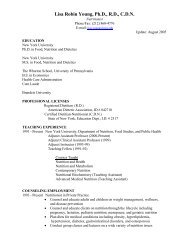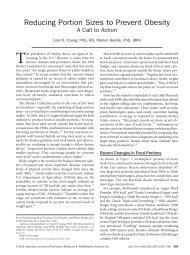WebMD Diets of the World: The Japanese Diet - The Portion Teller
WebMD Diets of the World: The Japanese Diet - The Portion Teller
WebMD Diets of the World: The Japanese Diet - The Portion Teller
You also want an ePaper? Increase the reach of your titles
YUMPU automatically turns print PDFs into web optimized ePapers that Google loves.
<strong>Portion</strong> power. In Japan, food is served on separate small plates and bowls instead <strong>of</strong> on<br />
one big plate. Diners take turns having little tastes <strong>of</strong> everything, Moriyama says. Serving<br />
smaller portions may be one <strong>of</strong> <strong>the</strong> best secrets for eating healthfully and losing weight.<br />
Research shows that when we’re served more, we tend to eat it -- whe<strong>the</strong>r we planned to<br />
and were hungry for it or not. People eat up to 45% more food when served bigger<br />
helpings, scientists from <strong>the</strong> University <strong>of</strong> Illinois, Urbana-Champaign report. When<br />
asked to identify what determines <strong>the</strong> size <strong>of</strong> <strong>the</strong> portions <strong>the</strong>y eat, nearly seven out <strong>of</strong> 10<br />
respondents in a recent American Institute for Cancer Research (AICR) survey claimed<br />
that <strong>the</strong> amount <strong>the</strong>y were accustomed to eating was what determined <strong>the</strong> amount <strong>of</strong> food<br />
<strong>the</strong>y placed on <strong>the</strong>ir plates.<br />
This is both bad news and good news. Bad, in that it’s pro<strong>of</strong> we tend to eat without<br />
thinking. And good, in that it’s possible to change <strong>the</strong> amount <strong>of</strong> food we eat. How? By<br />
becoming used to eating less. For instance, try replacing platter-size dinner plates with<br />
salad or dessert plates. You’ll end up eating less, while barely noticing, because your<br />
plate will look just as full. Or try serving food from measuring cups for a week or so, says<br />
Lisa R. Young, PhD, RD, author <strong>of</strong> <strong>The</strong> <strong>Portion</strong> <strong>Teller</strong> Plan, -- just to get used to <strong>the</strong><br />
amount <strong>of</strong> food you should be eating. “You don't have to shrink all your portions, just<br />
portions <strong>of</strong> high-calorie, high-fat foods,” she says.<br />
A rice foundation. <strong>The</strong> <strong>Japanese</strong> diet includes huge amounts <strong>of</strong> rice -- six times more per<br />
person than <strong>the</strong> average American’s diet, Moriyama tells <strong>WebMD</strong>. A small bowl is<br />
served with almost every meal, including breakfast. A low-fat, complex carbohydrate,<br />
rice helps fill you up on fewer calories, leaving less room in your belly for fattening<br />
foods like packaged cookies and pastries, which can contain heart-damaging trans fats.<br />
For extra health benefits, serve rice <strong>the</strong> <strong>Japanese</strong> way, cooked and eaten with no butter or<br />
oil.<br />
Veggie delight.“Japan is kind <strong>of</strong> a vegetable-crazed nation,” Moriyama says. When<br />
<strong>Japanese</strong> women were asked which home-cooked meals <strong>the</strong>y most loved to prepare for<br />
<strong>the</strong>ir families, “mixed vegetables simmered in seasoned broth” received <strong>the</strong> highest<br />
ranking. Red bell peppers, green beans, zucchini, eggplant, onions, burdock, tomatoes,<br />
green peppers, lettuce, carrots, spinach, bamboo shoots, beets, lotus root, turnips, daikon<br />
(or giant white radish), shiitake mushrooms, sweet potatoes, and seaweed (or sea<br />
vegetables), such as kombu, nori, and wakame all have a place in <strong>the</strong> <strong>Japanese</strong> diet. As<br />
many as four or five different varieties are served in a single meal -- and no one thinks it<br />
odd to have vegetable soup or a salad for breakfast. Veggies are served simmered in<br />
seasoned broth, stir-fried in a small bit <strong>of</strong> canola oil, or lightly steamed -- all methods that<br />
maintain a maximum amount <strong>of</strong> nutrients.<br />
A good catch. Fish, especially fatty fish -- like <strong>Japanese</strong> favorite’s salmon and fresh tuna,<br />
mackerel, sardines, and herring -- are a great source <strong>of</strong> omega-3 fatty acids, which are<br />
known for <strong>the</strong>ir heart-health and mood-boosting benefits, Moriyama tells <strong>WebMD</strong>. And<br />
though Japan accounts for only 2% <strong>of</strong> <strong>the</strong> world’s population, its people eat 10% <strong>of</strong> <strong>the</strong><br />
world’s fish. <strong>The</strong> flipside <strong>of</strong> Japan’s fish craze means <strong>the</strong> <strong>Japanese</strong> eat less red meat,




